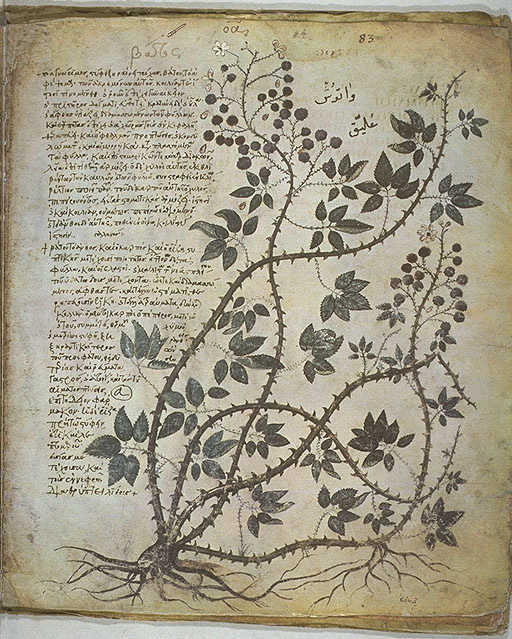De Materia Medica (Of Medical Subsances) by Dioscorides was written almost two thousand years ago. The original manuscript has never been found.
The oldest known copy (which was specially ordered as a royal gift) has been described by UNESCO as “the most important pharmaceutical source of the Ancient World”.
The five-volume manuscript (written around the year 77) describes approximately 600 plants for more than 1,000 traditional medicines.
During the first century, the Greek doctor and apothecary Pedanius Dioscorides (c. 40-90 CE); who is considered the father of pharmacology, wrote a very important document on botany and pharmaceuticals. As an army surgeon (with the armies of the Roman emperor Nero), Dioscorides traveled throughout the ancient world. He observed, collected, studied the features, distribution, and medicinal properties of many plants and minerals. Applying hundreds of plants to his medical practice . His De Materia Medica; hand-copied and edited countless times, would be extensively referenced by physicians and herbalists for the following 1,500 years. It is still referenced today.
For 16 Centuries after it was written, Dioscorides’ celebrated herbal reference was the basis of European and Western pharmacopeia. In contrast to many other classical works it was not “rediscovered” in the Renaissance, because it had never left circulation. The original Greek manuscript of De materia medica, was copied into at least seven other languages. In 1655 John Goodyer made an English translation from a manuscript copy. This wasn’t published until 1933 when it was edited by Robert T Gunther.
De Materia Medica – Focus
The focus of De Materia Medica is “the preparation, properties, and testing of drugs” – his main message is that investigation and experimentation were crucial to pharmacology.
The five-volume work covers the following: ‘On plant animals’, ‘On all manner of animals’, ‘On all manner of oils’, ‘On materials derived from trees’, ‘On wines and minerals and other similar substances‘.
The unique aspect of Dioscorides’ method of presentation was that he listed plants not alphabetically by name, as did many herbals. But in groups that had similar pharmacologic actions in the body.
Timelessness
That unique presentation is just one of the reasons why this book is still so useful to us today. It’s timelessness is also due to the empirical tradition based on trial and error; that it worked for generation after generation despite social and cultural changes and changes in medical theory.
The biggest problem that we have today is: ‘to what extent are the Latin binomials correctly ascribed to the plants described by Dioscorides?’. His descriptions are usually brief and often refer to other plants. The authoritative translation of De Materia Medica is by Lily Beck (2017). This uses the Latin binomials given by Jacques André who was a French expert in Greek and Latin naming. However, he was not a botanist.
There are herbs from Dioscorides ancient world that we have yet to identify.
Dioscorides most famous quote is: “Nature will never follow people but people will have to follow the laws of nature.”
